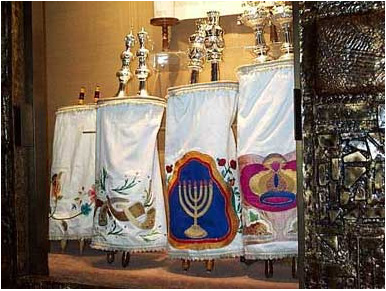
Holiday Torah Mantles
The prayerbook for the High Holidays, known as the Machzor, tells us that God is judging our lives. We can defer or reverse a negative judgement against us through three things.
- Tefilah
- Teshuvah
- Tsedakah
The shofar represents the near sacrifice and the binding of Isaac (Akedah). On Rosh Hashanah we read from the Torah that as Abraham was about to sacrifice Isaac, he heard the voice of God instructing him to stop. Abraham looked up and saw a ram caught in the thicket by its horns. The ram was used as a sacrifice in place of Isaac.The ram’s horn (Shofar) is a reminder to God and to us of the covenant established with Abraham, Isaac and their descendants; a covenant of commitment from God to His people and a promise of faith, a willingness to sacrifice and a pledge of loyalty from His people. By focusing on the covenant and our obligations to God, the Shofar serves as a call to prayer. The Shofar is the timeless bridge between the sacrifice that almost ended the life of the Jewish people and the prayers raised to heaven that sustain us.

Teshuvah
The Menorah, Judaism’s oldest symbol, represents the seven branched menorah that stood in the holy of holies. As we read in Leviticus, the holy of holies was central to the rituals on the Day of Atonement (Yom Kippur). On Yom Kippur, the high priest (kohen gadol) would stand within the holy of holies in the Temple in Jerusalem and pray for God to forgive all his sins, the sins of his family, of all the priests and Levites and of all the people of Israel. It was a moment full of apprehension. The people of Israel were afraid that the high priest would not survive so close to God’s presence. When the high priest uttered the divine name and emerged unscathed, the people exclaimed “blessed be God’s glorious kingdom, forever and ever.”The pomegranates, symbols of wisdom, hung like bells on the fringes of the high priests garments. Bells and pomegranates whispering their prayers of hope and deliverance to God.
Tsedakah
Rabbi Shimon said that the crown of good name is worth far more than the crown of royalty, knowledge or priesthood. We attain our good name through the performance of righteous actions known as Tsedakah. Tsedakah, more than any other mitzvah, requires us to perform acts of righteousness and lovingkindness to create a more just world. Subject to the majesty and sovereignty of God, the lions of Judah represent the Jewish people who maintain God’s covenant found in Torah. As we recite in our prayerbook, “it is a tree of life to those who hold fast to it and all who support it are happy.”
Bereshit – creation
Rosh Hashanah is considered the birthday of the world, the anniversary of creation. Pomegranates represent the tree of knowledge of good and evil that stood in the legendary Garden of Eden. The six-petalled flower represents the tree of life which also stood in the garden. It’s six petals are symbolic of the presence of God above and below and at the four corners of the world. The six petals also represent the six pointed star of David and the six days of creation.According to the rabbinic text, “seder olam raba”, we date the first day of the first year from the moment when Adam and Eve ate of the fruit of the tree of knowledge. On that day, humankind became aware and began to change the world. We celebrate the five thousand, seven hundred and sixty-one years since that event when we left the garden and civilization began.

![shofar_detail_web[1]](https://tbi-lbk.org/wp-content/uploads/2014/05/shofar_detail_web1-257x300.jpg)

![menorah_detail_web[1]](https://tbi-lbk.org/wp-content/uploads/2014/05/menorah_detail_web1-252x300.jpg)

![crown_detail_web[1]](https://tbi-lbk.org/wp-content/uploads/2014/05/crown_detail_web1-300x225.jpg)

![pomegranate_detail_web[1]](https://tbi-lbk.org/wp-content/uploads/2014/05/pomegranate_detail_web1.jpg)